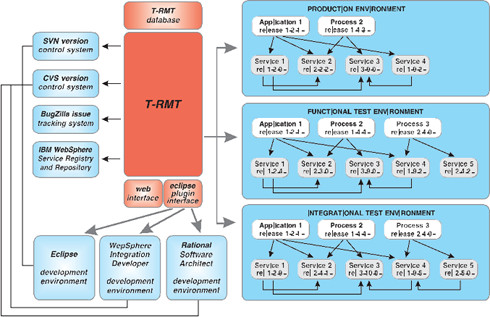T-Logic Release Management Tool for SOA (TRMT)
TRMT is a tool for managing application life cycle in a distributed application development environment. By discovering dependencies between components and governing the whole release process it provides visibility and control for developers and IT operations over the applications. Visibility and control lets the IT deliver software on time and on budget with the required functionality. It is mandatory for successful SOA!
Technology with visibility and control in sight: How many teams and solution providers are working on your applications at the same time? Are your application components incompatible In distributed environments presumably distributed teams are working on developing applications that are based on common services and components. In this article we are introducing T−Logic Release Management Tool for SOA. TRMT is a tool for keeping the distributed development process visible and under control, and simplifies this task by automatically discovering the dependencies between the services, processes and applications by analyzing source codes. Thus TRMT helps the organization to adhere to the ITIL requirements regarding release management.
Click here and download the detailed product brochure.
Why?
In distributed environments, where many application components are working together to provide the required functionality, co−ordinating and synchronizing the developers' activities can be challenging. Service Oriented Architecture (SOA) introduces further concepts like reuse of components in multiple processes and applications. In this situation you cannot change one service component without paying attention to the applications that are using it. Functional requirements of an application are usually fulfilled by a joint effort of many components, so tracking the status of the realization of these requirements in the components of the application is necessary to create consistent releases.
What?
- You want to know the dependencies between the components in order to be able to determine whether you can change one part without affecting other parts or not. In a distributed environment following the dependencies manually is simply not feasible. With time, the reality and the documentation typically get unsynchronized.
- You need to make sure that all of the components provide their own sub functionality that together add up the required functionality of the application. This determines when the release is in a functional and consistent state.
- You need to avoid the situations where incompatible application versions are deployed in an environment, so you need to know what components are compatible with each other. In short you need a solution that manages the whole SOA development process and the application life cycles effectively.
How?
TRMT's unique feature is that it automatically discovers the dependencies between the components via source code analysis. Thus this information is always 100% correct and free of errors. TRMT provides an Eclipse plug−in and supports most of the common versioning systems, so the developers can continue to use the development environments and versioning systems they are used to. TRMT supports development in parallel processes, with each process producing releases when a consistent state is achieved. The tool helps to determine these points by tracking the status of components involved in fulfilling the requirements. To support the full development lifecycle, TRMT is able to automate the build and deployment of the releases by using scripts, even into remote systems. TRMT can be integrated with issue tracking systems and Service Registry to provide support for controlling service lifecycle in a Registry, which is a key infrastructural component and cornerstone for SOA deployments.
To whom?
- Application (process, service, etc.) owners have control over what issues (bug fixes, new features) have to be addressed in a release, and can follow the status of their realization. They can also follow the realization of demands that an application imposes on dependent projects.
- TRMT provides assistance for developers during the whole application development life cycle, through the development and testing iterations.
- Using build and deploy scripts TRMT helps IT operations to automate these tasks and provides the possibility of rollbacks as well.
- Auditors can use TRMT queries to answer audit−related questions (e.g. who has delivered a change to a release and who has deployed it?).
Why TRMT?
- Enables quality control and real reuseability in a constantly changing environment. Position of TRMT in the architecture in an established SOA architecture, TRMT is typically managing the releases of about a hundred services and a dozen applications and processes building upon these services, in several environments.
Position of TRMT in the architecture

In an established SOA architecture, TRMT is typically managing the releases of about a hundred services and a dozen applications and processes building upon these services, in several environments.
For further details about the product see our TRMT Whitepaper.
